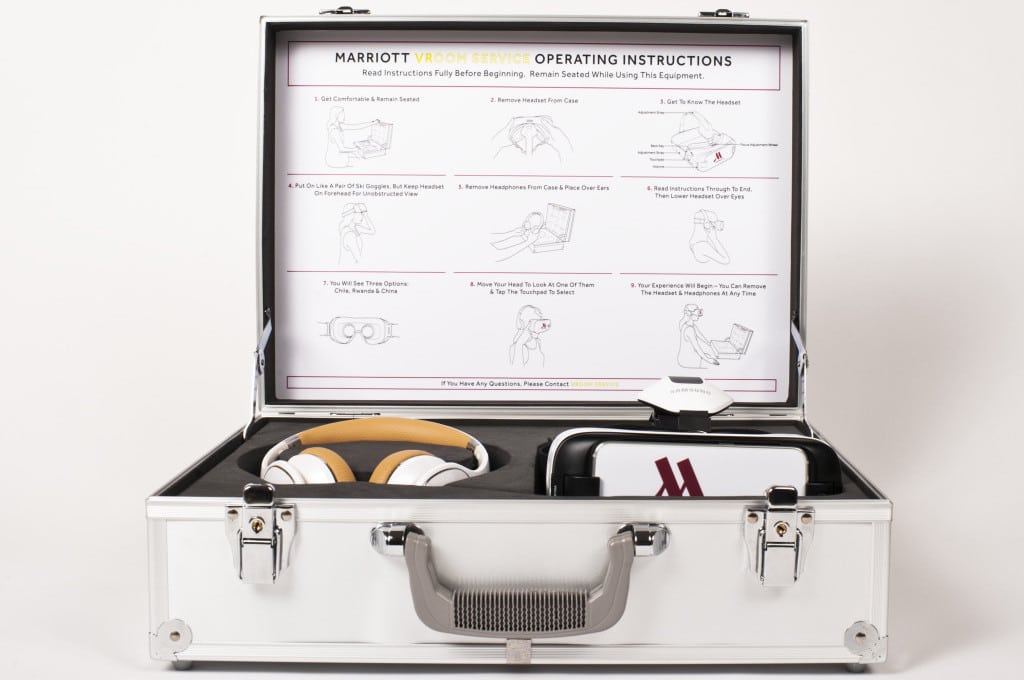Skift Take
It's no marketing plug. Marriott's two-week VR Room Service experiment, complete with the introduction of its own VR Postcards platform, takes visual storytelling in travel to a new dimension in an effort to stay relevant, connect with millennials, and foster a conversation around why people travel.
Guests at Marriott’s New York and London locations can take round-the-world trips across Asia, South America, and Africa right from their hotel rooms through the limitless world of virtual reality storytelling.
Launched Wednesday and currently being tested at the New York Marriott Marquis and London Marriott Park Lane properties, VR Room Service is a two-week experimental program that allows guests to have a Samsung Gear VR headset delivered to their rooms and borrow it for 24 hours. Users can explore the various content available on Samsung’s Milk VR platform — basically the virtual reality for iTunes, says Michael Dail, the vice president of global brand marketing at Marriott Hotels.
As part of the service, Marriott also launched its own VR Postcards, a digital content platform comprised of three virtual travel stories told from Chile, China and Rwanda in an immersive, 360 degree experience.
“This is kind of in a sense how people live, they are very connected and want to stay performing when they travel,” Dail says.
Each video, which is under three minutes a piece, is narrated by a different traveler. Alexis Miesen, owner of Blue Marble Dreams, takes us to the ice cream shop she opened in Rwanda while in a separate video Camillo Alvarez, a gallery owner, takes us to the narrow laneways of Beijing known as hutongs, crowded with locals and small vendors and restaurants where the dumplings look so good you will try to reach out and grab one. Erica Bryndza, a marketing executive, takes users to experience the serenity and solitude settled high atop the Andes mountains in Chile, peaks bubbling all around like champagne bubbles.
With this experiment comes Marriott’s desire to continue fostering connections with and meet the needs of millennials through visual storytelling.
“The virtual travel is another way to [meet the next generation of travelers],” Dail says. “We wanted to add a storytelling element because so many millennials are content creators themselves, you know they are on snapchat or Instagram sharing their travel stories. It is really those kind of entrepreneurial insights of what motivates people and what they take away from travel, both professionally and personally.”
Alexis Miesen of Blue Marble Dreams says that she is constantly looking for innovative ways to tell the story of the ice cream shop she opened in Rwanada in 2010.
“This is a way to tell that story with a whole new dimension to it, and I was really intrigued by that opportunity,” Miesen says. “Especially in a place like Rwanda, which is so foreign, to be able to bring people into the adventure and to put them in that place helps them to understand better what it is like to actually be there.”
Though there may be some guests who rent out the headsets to play around with the technology, there other guests who may think, ‘I love this, I can relate to this, what other destinations and stories can we tell?’ Dail says.
Which brings Dail to the future of storytelling through virtual reality: the possibility for consumers to create their own stories to share with friends and family as technology evolves.
“Instead of having social media or Instagram, you can send to your parents or anybody else a quick virtual clip,” Dail says. “The technology doesn’t exist now, but looking at what has been happening in the span of year, who knows what will happen.”
Have a confidential tip for Skift? Get in touch
Tags: content marketing, hotels, marriott, social media
Photo credit: Slap on the Samsung Gear VR headset and take a trip around the world with Marriott's VR Postcards. Marriott / Marriott International
